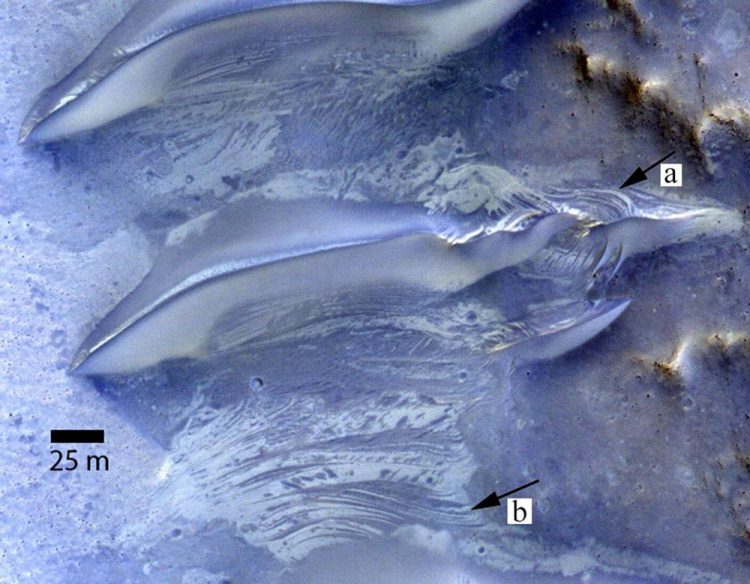Researchers pinpoint watery past on Mars

a) Exposure of putative crossbeds on windward slope of dunes on Mars b) Interdune strata exposed in planform showing contrasting albedo and crosscutting relationships similar to that exposed in the dune. Subset of false-colour HiRISE image ESP_013319_1685. The Infrared, red and blue bands are displayed as red, green and blue. Credit: Dr Mary Bourke (Trinity College Dublin).
The findings have just been published in Geophysical Research Letters, by Dr Mary Bourke from Trinity, and her colleague, Professor Heather Viles, from the University of Oxford.
Dr Bourke said: “On Earth, desert dunefields are periodically flooded by water in areas of fluctuating groundwater, and where lakes, rivers and coasts are found in proximity. These periodic floods leave tell-tale patterns behind them.”
“You can imagine our excitement when we scanned satellite images of an area on Mars and saw this same patterned calling card, suggesting that water had been present in the relatively recent past.”
In a remote sensing study of the Namib Desert, the researchers had previously noted these patterns — 'arcuate striations' — on the surface between migrating sand dunes. Fieldwork subsequently showed that these arcuate striations resulted from dune sediments that had been geochemically cemented by salts left behind by evaporating groundwater. These dune sediments later become relatively immobile, which means they are left behind as the dunes continue to migrate downwind.
Dr Bourke added: “Following our work in Namibia, we hypothesise that on Mars, similar arcuate striations exposed on the surface between dunes are also indications of fluctuating levels of salty groundwater, during a time when dunes were actively migrating down the valley.” ** See Image 2 to visualise this **
“These findings are hugely significant. Firstly, the Martian sand dunes show evidence that water may have been active near Mars' equator — potentially in the not-too-distant past. And secondly, this location is now a potential geological target for detecting past life forms on the Red Planet, which is important to those involved in selecting sites for future missions.”
Media Contact
All latest news from the category: Physics and Astronomy
This area deals with the fundamental laws and building blocks of nature and how they interact, the properties and the behavior of matter, and research into space and time and their structures.
innovations-report provides in-depth reports and articles on subjects such as astrophysics, laser technologies, nuclear, quantum, particle and solid-state physics, nanotechnologies, planetary research and findings (Mars, Venus) and developments related to the Hubble Telescope.
Newest articles

A new look at the consequences of light pollution
GAME 2024 begins its experiments in eight countries. Can artificial light at night harm marine algae and impair their important functions for coastal ecosystems? This year’s project of the training…

Silicon Carbide Innovation Alliance to drive industrial-scale semiconductor work
Known for its ability to withstand extreme environments and high voltages, silicon carbide (SiC) is a semiconducting material made up of silicon and carbon atoms arranged into crystals that is…

New SPECT/CT technique shows impressive biomarker identification
…offers increased access for prostate cancer patients. A novel SPECT/CT acquisition method can accurately detect radiopharmaceutical biodistribution in a convenient manner for prostate cancer patients, opening the door for more…





















